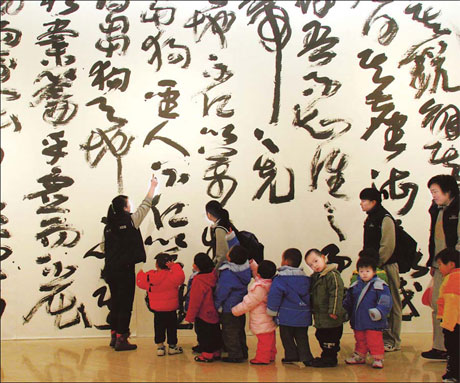


The nation's museums, both public and private, are reaching out to the public in a way never before attempted with free admissions, special discounts and better services. Zhu Linyong reports
Hou Zhiqing, an art enthusiast from Inner Mongolia, spends most of her spare time wandering around Beijing's museums and galleries. The 32 year old, who makes a living by taking photograph for tourists to the Chinese capital, says she pays particular attention to information about lectures and interactive events for visitors. Recently, she attended a two-hour lecture and discussion on Chinese contemporary art at the National Art Museum of China, along with some 200 others.
The lecture was delivered by Zhu Qingsheng, an art professor with Peking University. Hou found it informative although she admits freely that she did not understand everything the professor said.
"But with such help one gains a better understanding of the exhibits," says the primary school dropout from the remote city of Fengzhen.
Recalling the 1990s, she says back then there were "no brochures, no audio guides, and no lecturers".
"Art museums and galleries are now becoming more accessible to visitors."
But the change only came after a barrage of criticisms from art educators, artists and public figures.
In 2007, outspoken artist and writer Chen Danqing said: "We have many art museums. But there is no art museum culture.
"Art museums should not function merely as an exhibiting space for a handful of artists. It should assume the more important role of serving the public," he noted.
Most art museums in China are actually art galleries financed by public funds, says curator Feng Boyi.
"What they are doing is holding commercially driven art exhibitions and selling tickets."
However, Fan Di'an, dean of the National Art Museum of China, points out that art museums are adjusting to the changing times and catching up with their Western counterparts.

Fan has been dean of the nation's most influential art museum, founded in 1962 with public funds, since December 2005.
He remembers that when he first took up the job, he spent two weeks strolling the exhibitions halls only to find that museum staff easily outnumbered the visitors.
That led him to initiate a series of measures which now place the museum alongside the National Center for the Performing Arts, Capital Museum, Forbidden City Concert Hall, and Capital Theatre, as a major cultural venue in Beijing.
It attracts more than 1 million visitors annually but Fan knows this number is still small.
While art museums offering free admission have seen a dramatic increase in attendance, not all are able to do so.
But most do have some sort of preferential policy, says Fan whose museum offers free admission to military personnel, disabled persons, people above 60 and under 17, and discounts to teachers and students.
However, Zhu Zhihong, deputy head of Hubei Art Museum, the first non-profit art museum at provincial level to allow visitors in for free in late 2008, says: "Free admission is just a minor step in attracting attention."
While his museum now draws at least 350,000 visitors annually in contrast to the average 120,000 visitors over the past two decades, Zhu insists art museums must work harder to improve their services, especially for the elderly, children and disabled persons, devise creative exhibitions, and hold educational programs for both adults and children.
"Visiting an art museum is gradually becoming an integral part of life for urban people," says An Yuanyuan, an official with the Ministry of Culture.
But some provincial-level art museums such as the Sichuan Art Museum have taken the initiative to hold "exhibitions on the move" programs for rural people since May last year.
Zhou Wenhan, a young art critic in Beijing, believes public art museums complement commercially-driven art galleries in places such as the 798 Art Zone in showing "what is good and what is bad art".
Private museums, with their smaller collections, cannot meet the growing cultural needs of an increasingly affluent population, he says.
The nation's first modern museum - the Nantong Museum - was built in 1905 by entrepreneur Zhang Jian, in Jiangsu province.
In 1936, the Kuomintang government established China's first publicly funded art museum - the National Art Museum of China in Nanjing.
In the first three decades of New China, there were fewer than 20 art museums.
From 1976-2004, China had about 100 art museums.
By the end of 2008, China had reportedly more than 1,700 art museums, alongside thousands of art galleries set up by individuals and corporate entities.
Still more art museums are mushrooming on China's urban landscape.
Most recently, the Jiangsu Art Museum, with a floor space of more than 10,000 square meters opened to the public for free, offering not just exhibitions, but also a variety of public art education programs for different age groups, according to museum dean Gao Yun.
A behemoth private art museum, The Himalayas Art Museum, covering a floor space of over 28,000 square meters, opened recently in Shanghai.
Yang Yingshi, a researcher in public art education with the National Art Museum of China expressed optimism for the future.
"China's art museum sector has yet to usher in a gold era," he says.